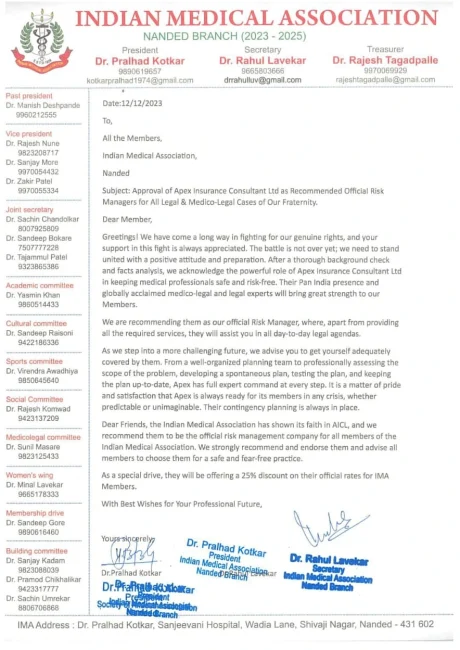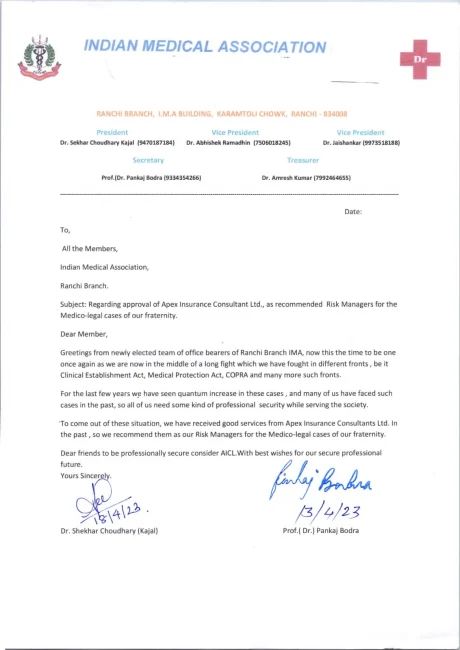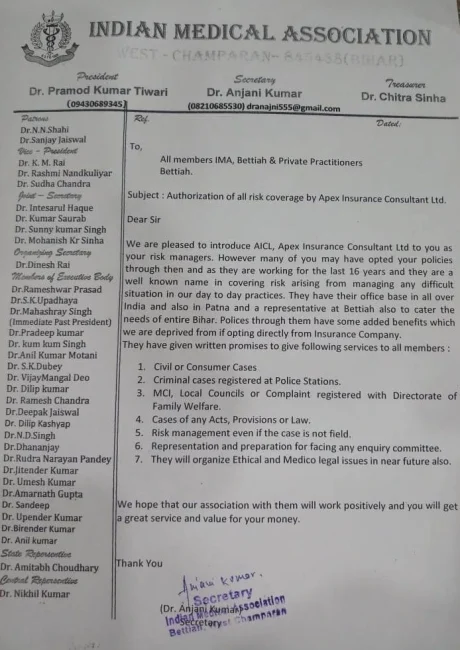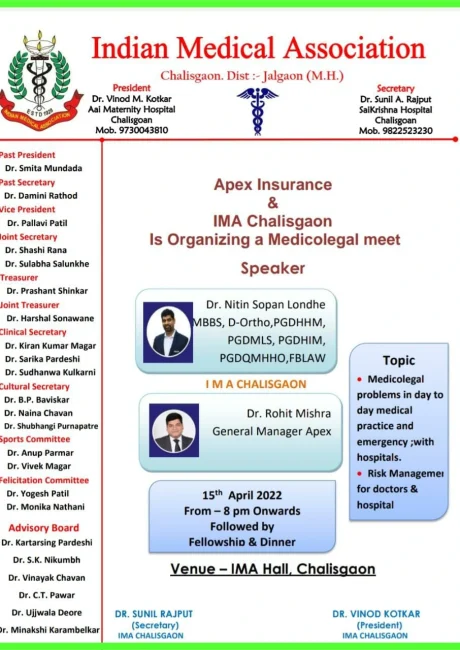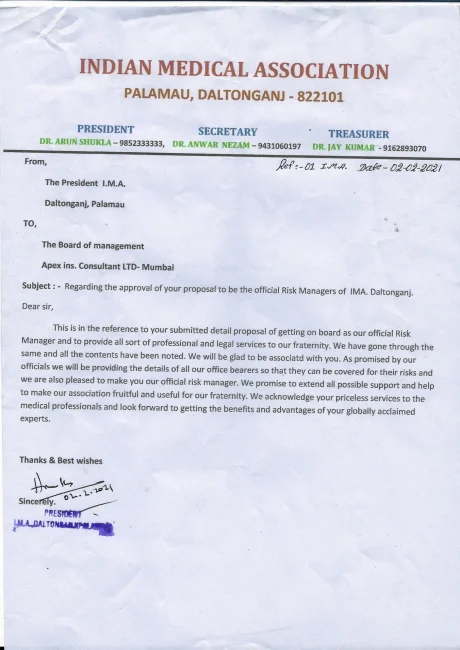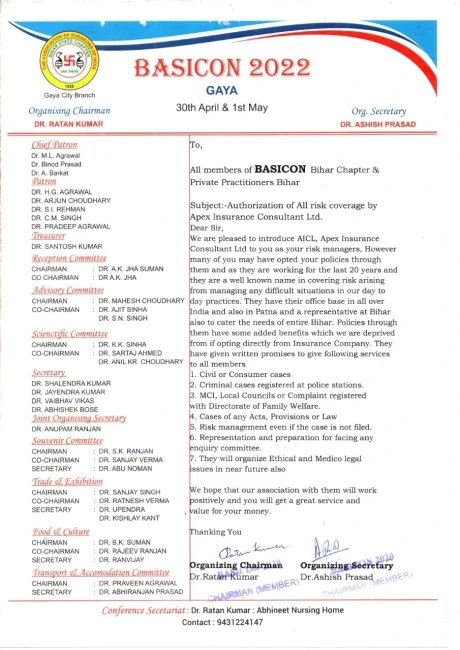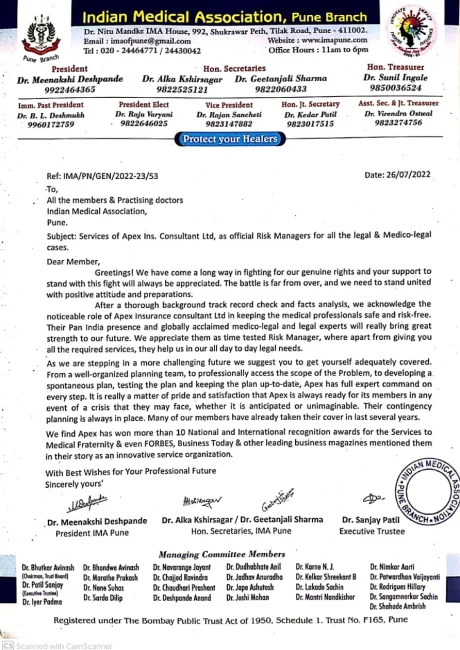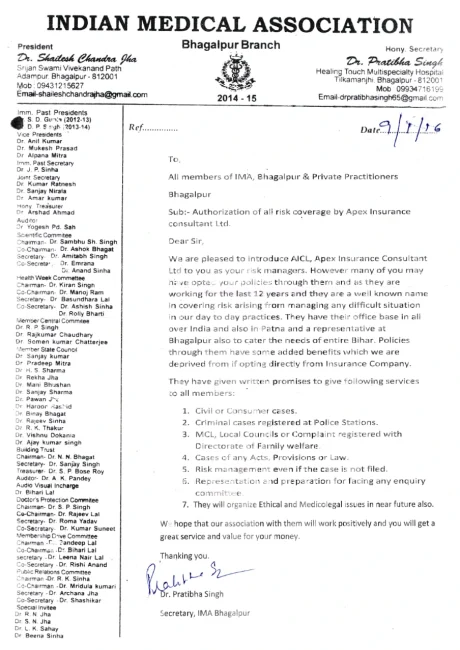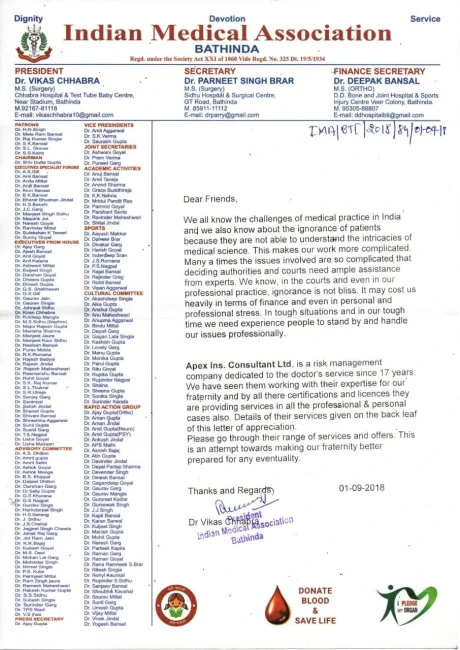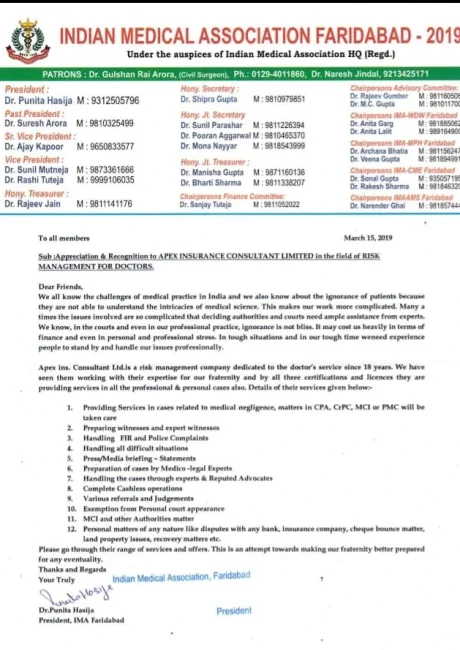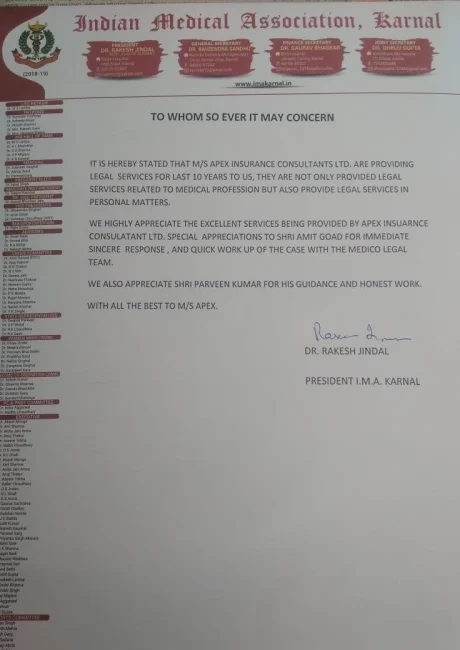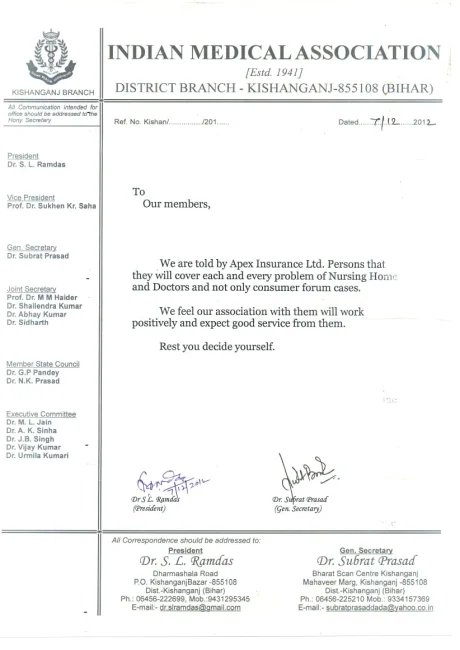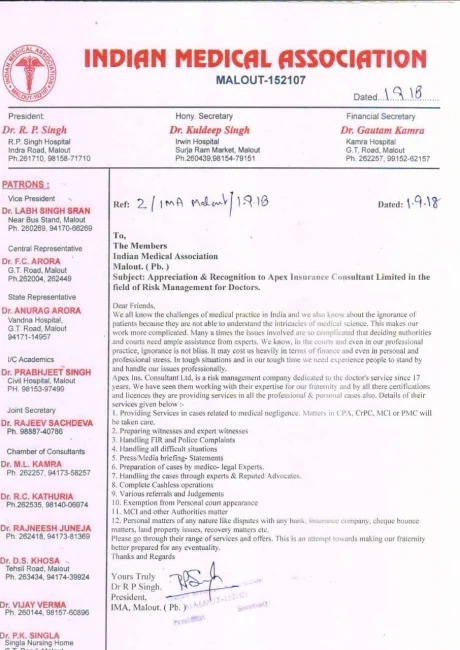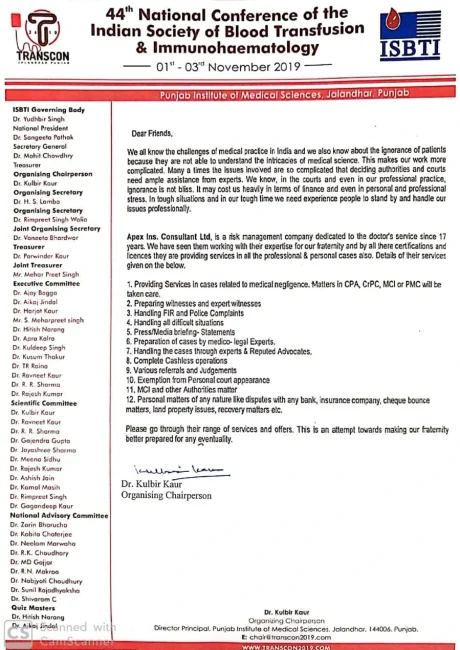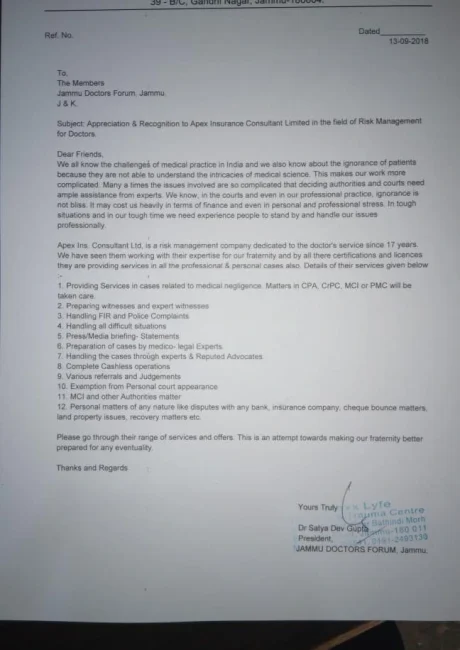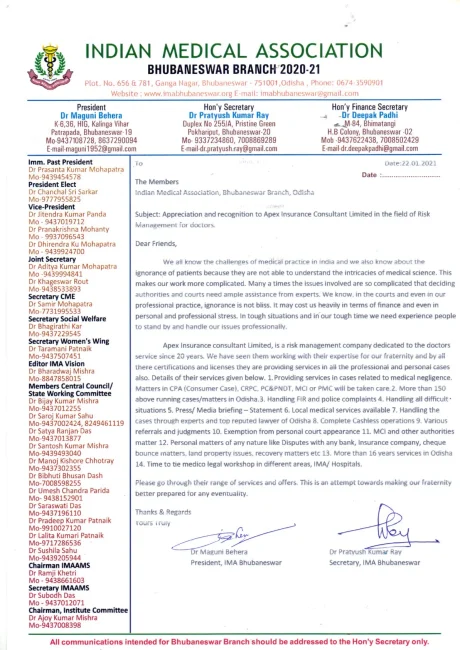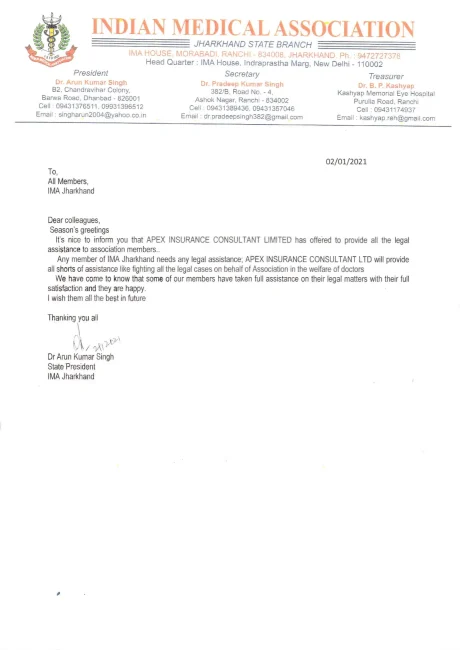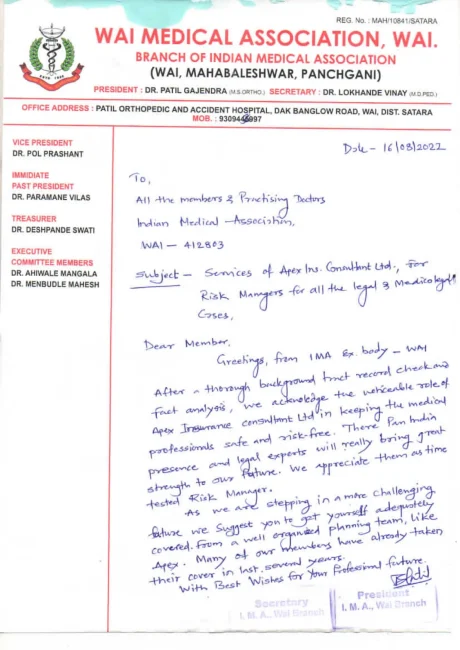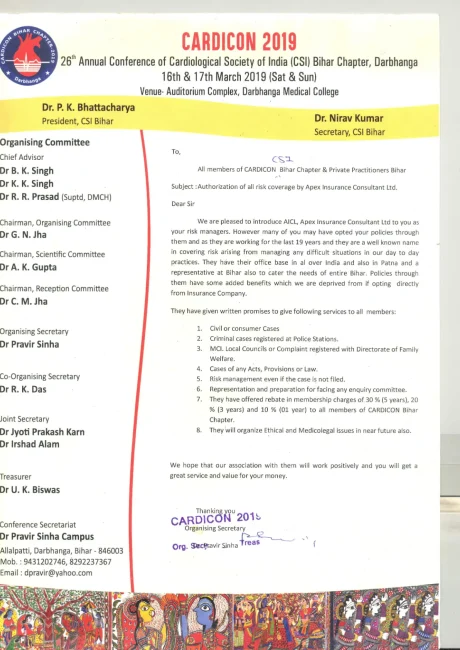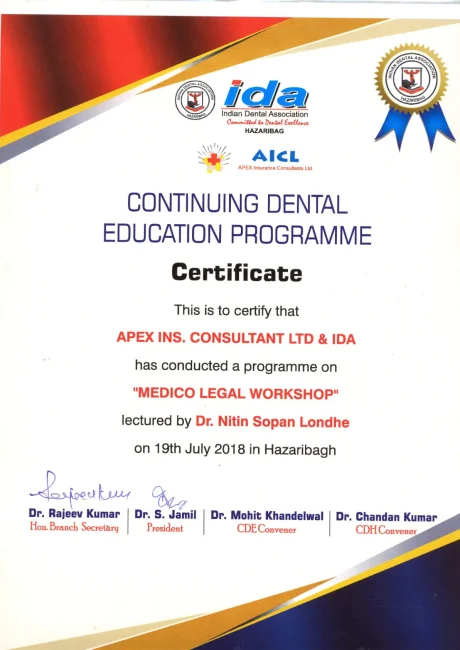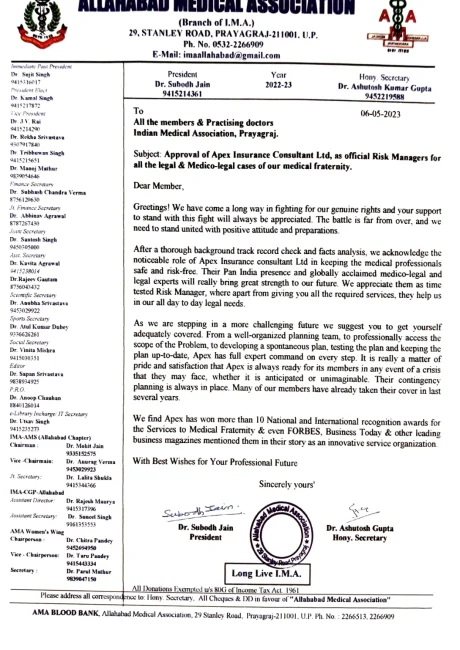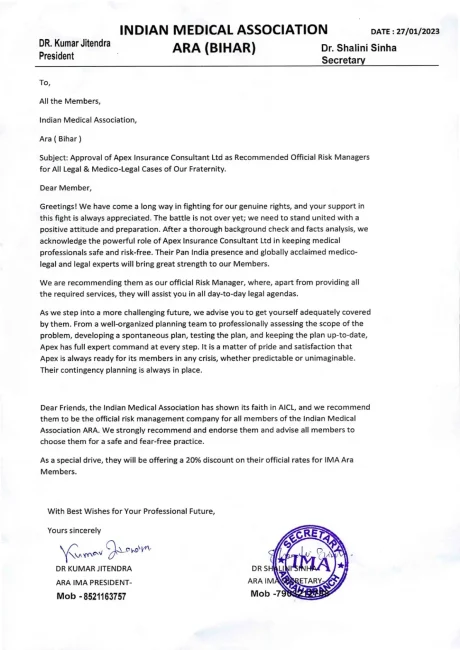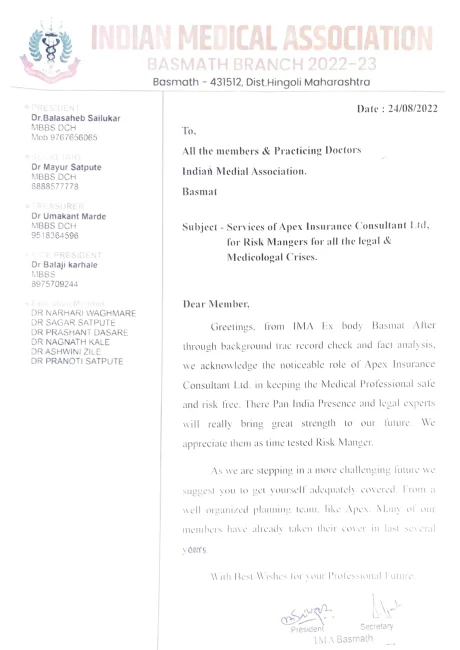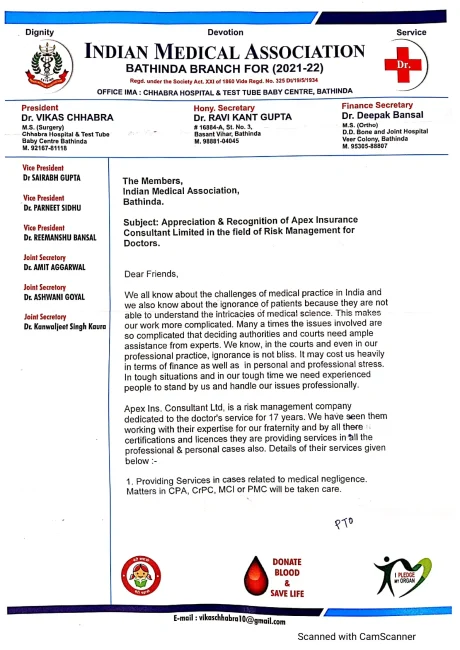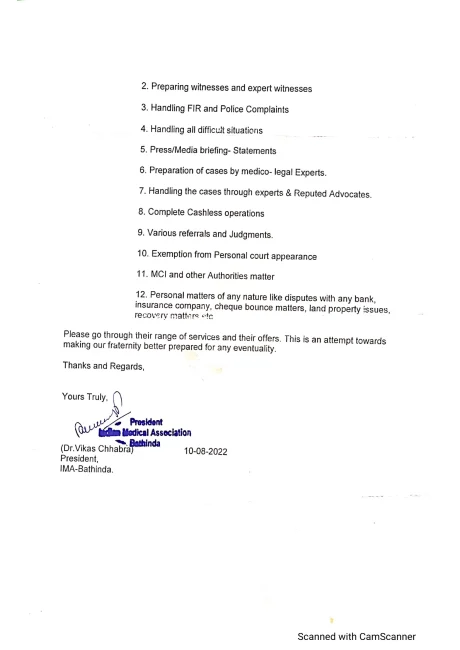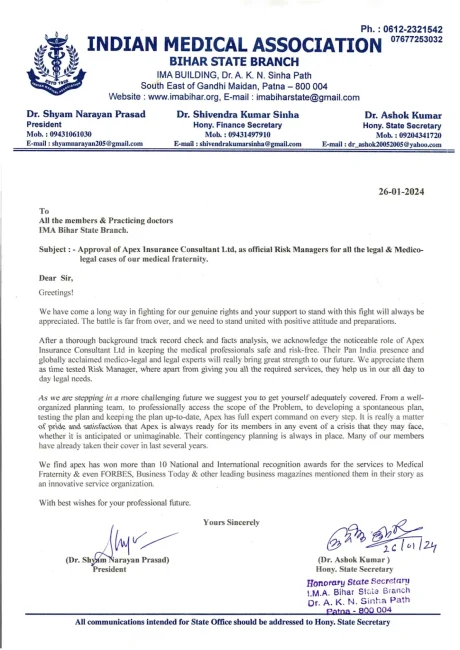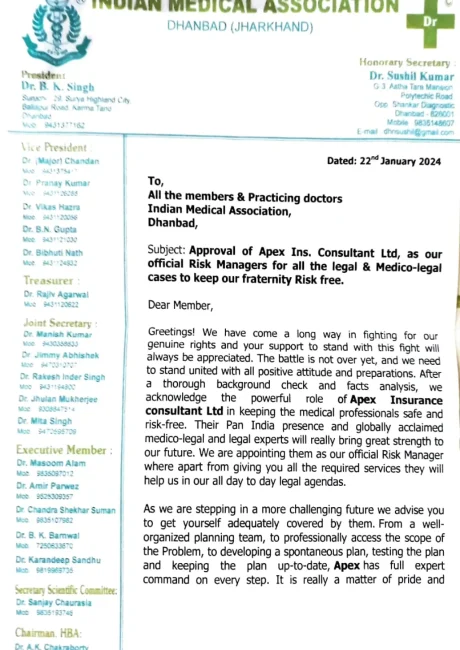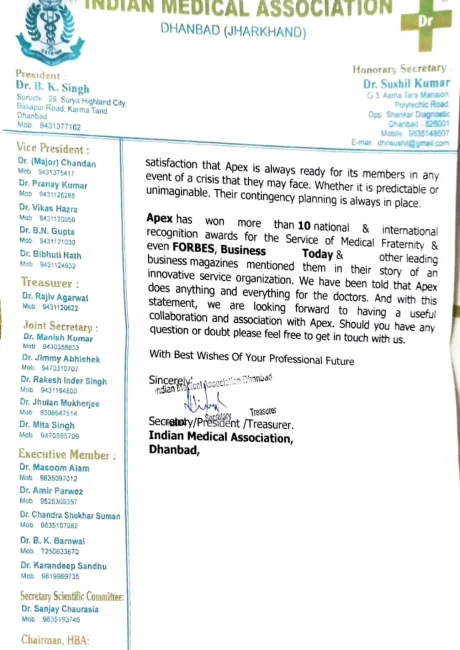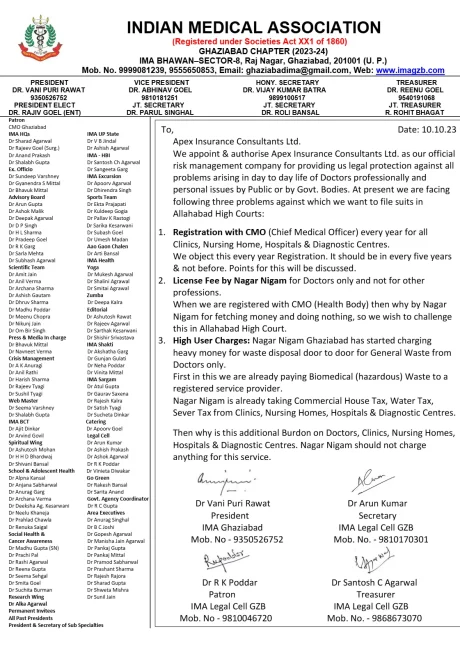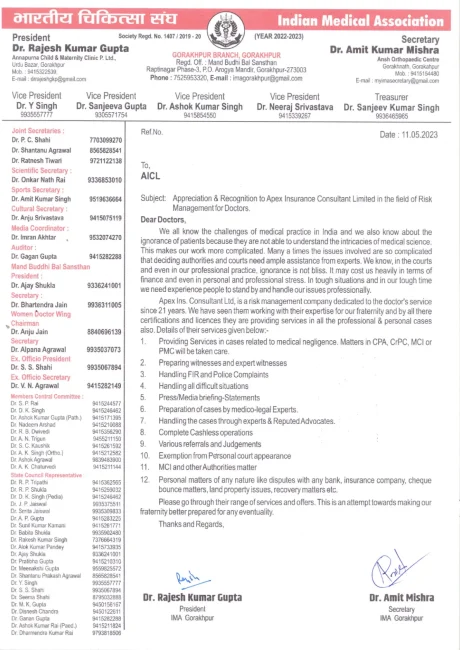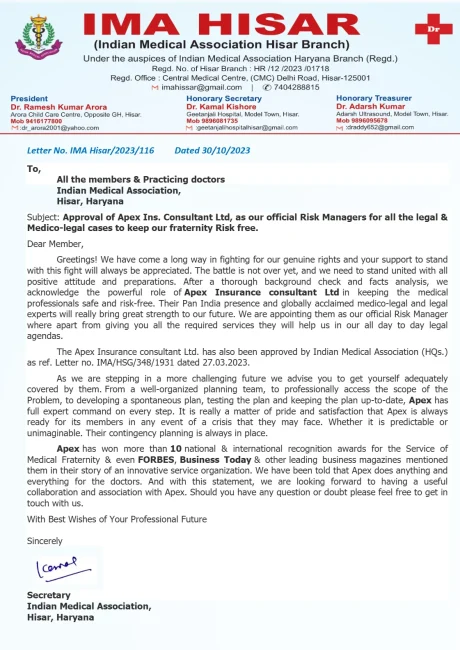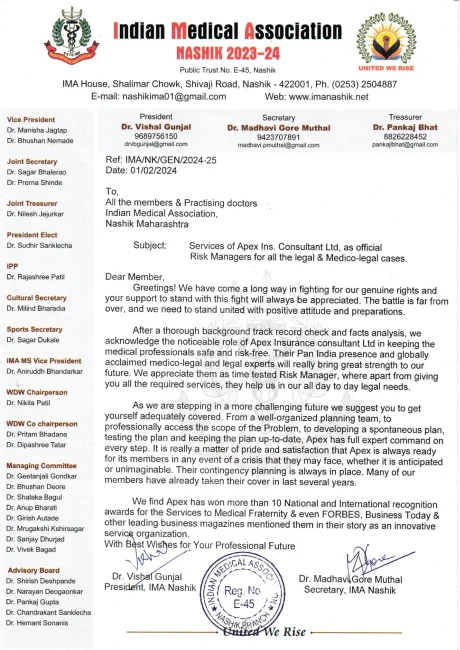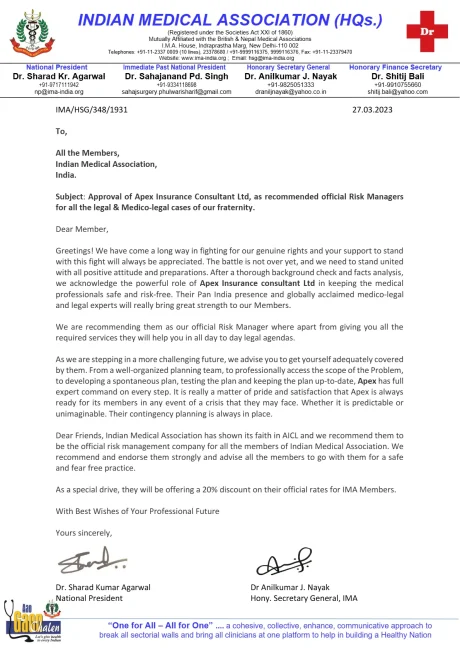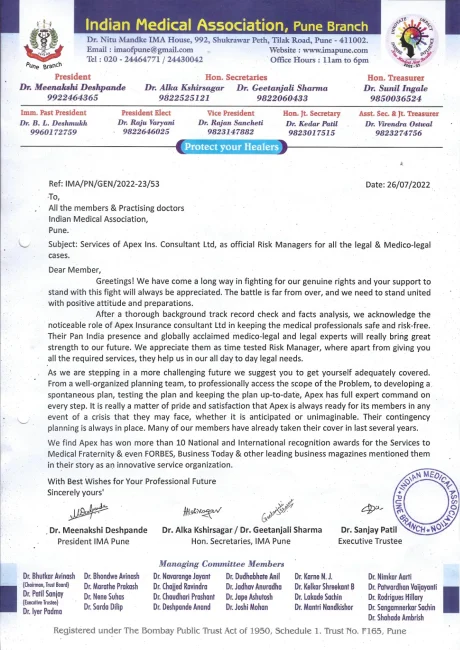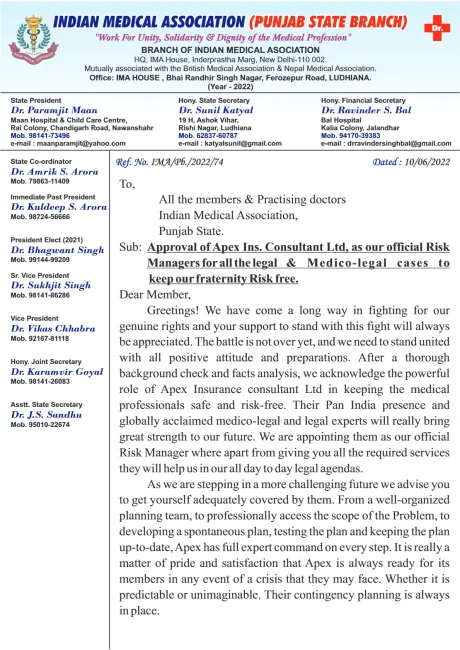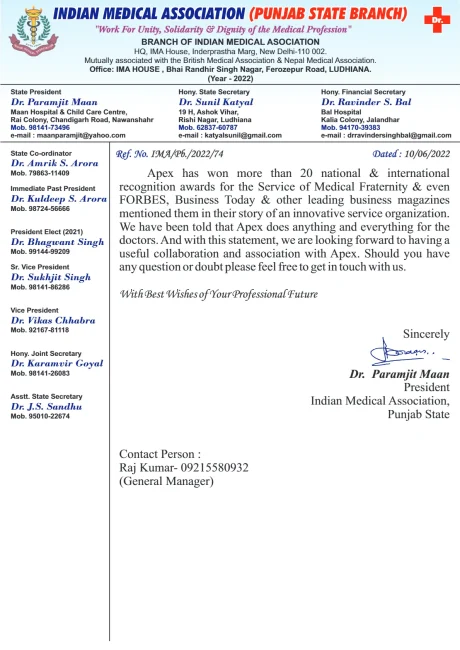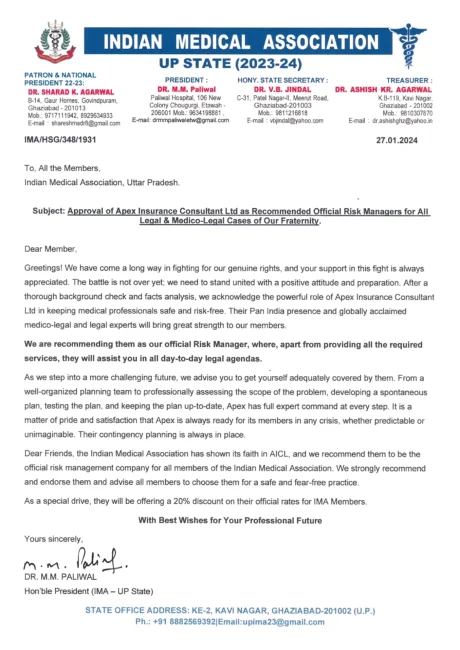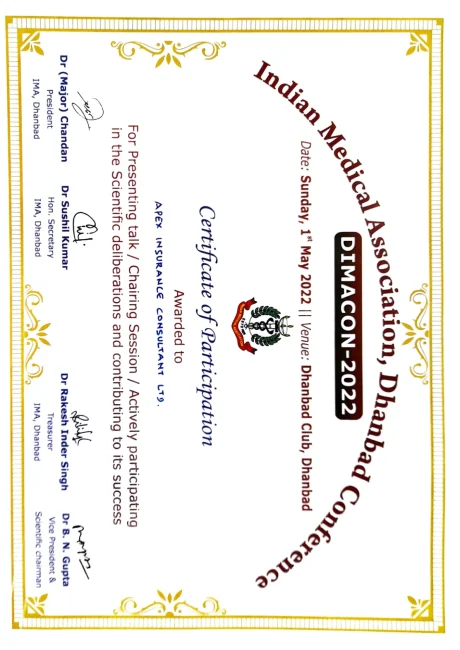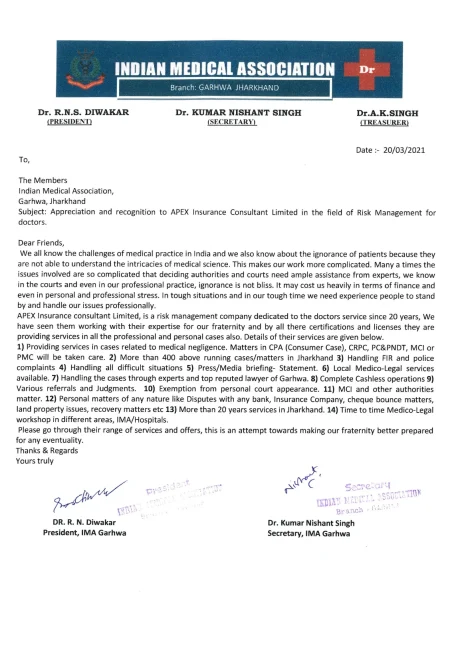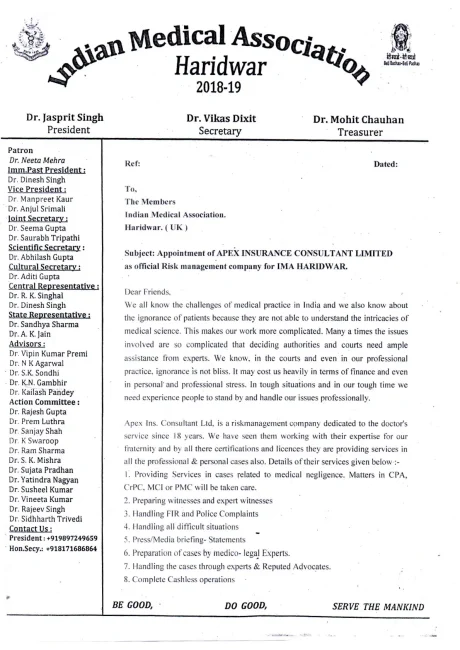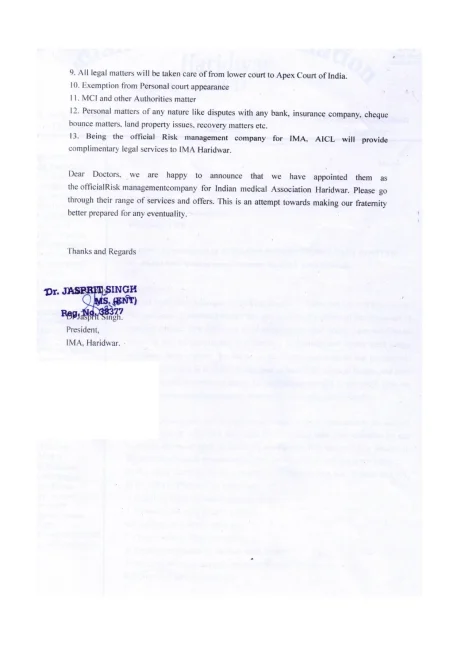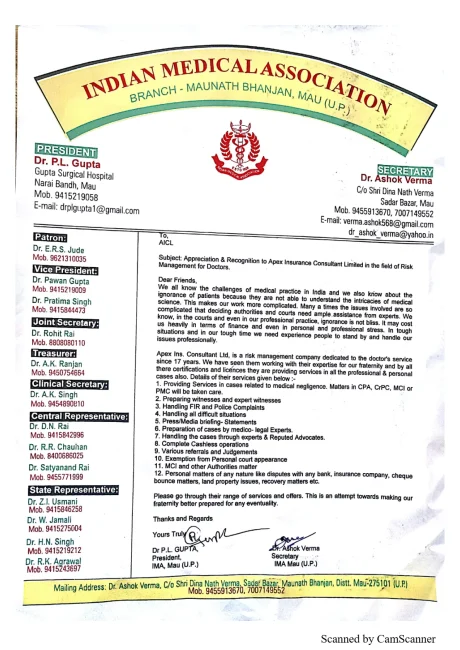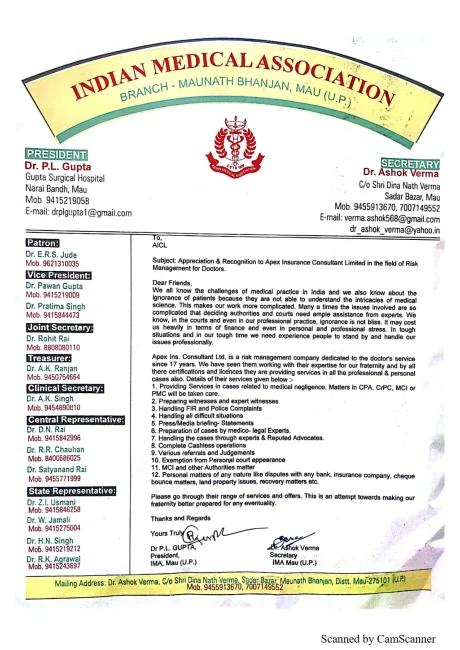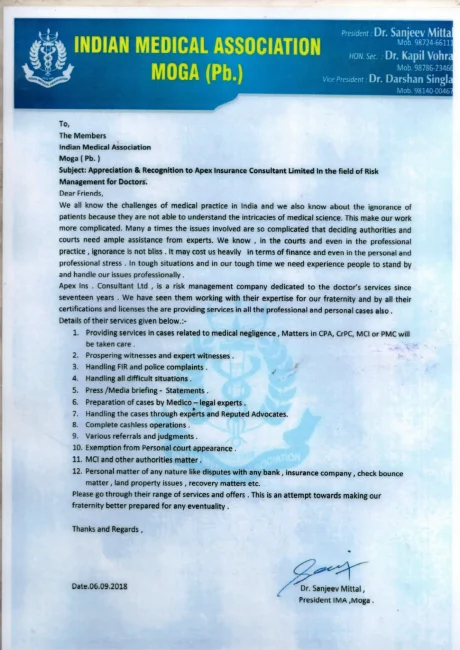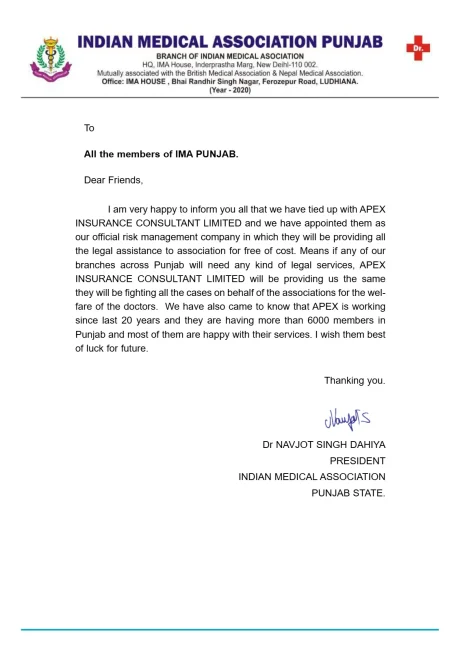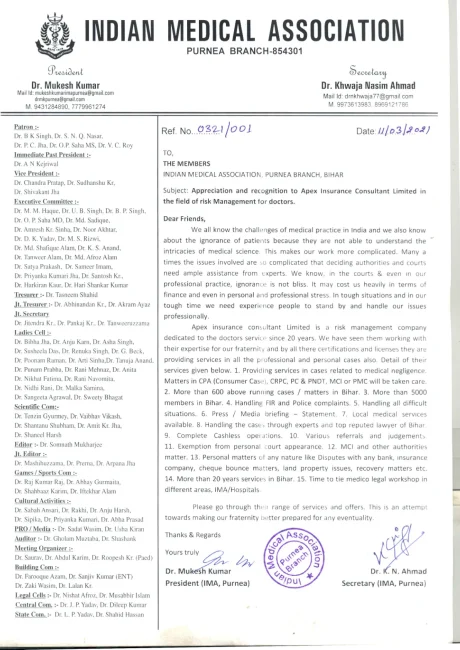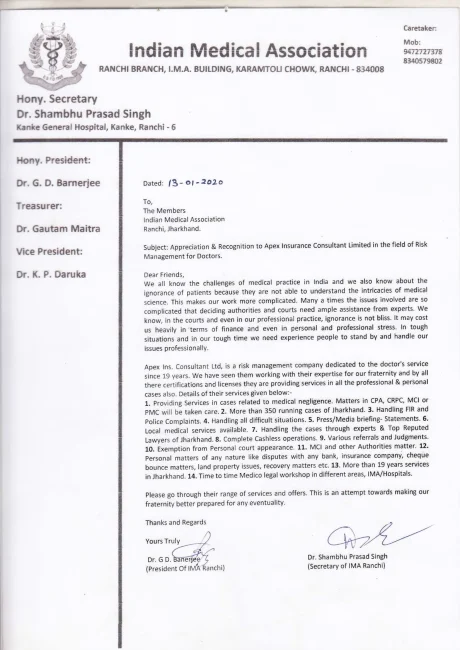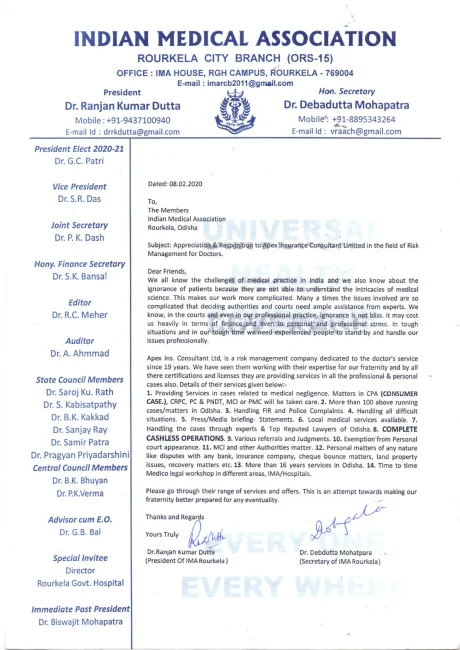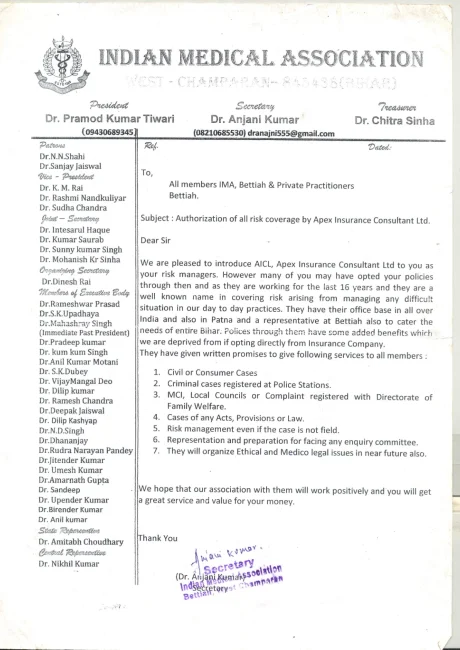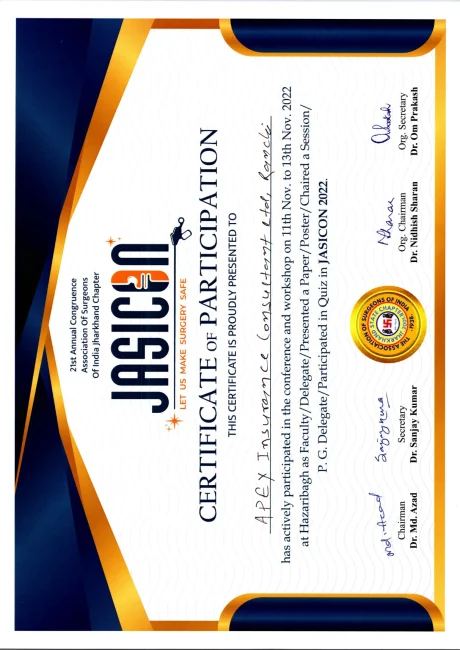By Dr. (Prof.) Mahesh Baldwa,
M.D, D.C.H, FIAP, MBA, LL.B, LL.M, PhD (law)
SENIOR PEDIATRICIAN & MEDICOLEGAL ADVISOR,
Baldwa Hospital, Sumer Nagar, S.V. Road, Borivali (West) Mumbai 400 092
2. Dr Namita Padvi, MBBS, MD,DNB, PGDML, Fellowship in pediatric anesthesiology, Assistant Professor of Pediatric medical s at T.N. Pediatric medical College and Nair Hospital, Mumbai-400008
3. Dr Varsha Gupta, MBBS, MD, PGDML, Senior resident in department of pathology, Government medical college, kota, Rajasthan
WHAT IS THE INDIAN LAW WHICH AFFECTS SAFE GUARDING CHILDREN
Doctors are being given new backing to report suspected child abuse after pediatricians voiced fears boomeranging reporting in high-profile cases have deterred some doctors from acting on their suspicions. But it is vital that doctors should be able to use their professional judgment without the fear of repercussions.” Doctors must report concerns about child neglect or abuse even if they only have a ‘hunch’ something is wrong with child which does not fit in the disease pattern but fits in abuse, be it mental, physical, emotional or sexual. Doctors should report fearlessly to safeguard children.
Doctors have an important role in detection and referral of child abuse. Doctors find safeguarding children complex and challenging. To complicate matters, the landscape is always changing as new information comes to light. Doctor should have a child protection concern and they should report to the authorities.” When a parent or guardian brings a child to the Emergency Room or Pediatric Outpatient Clinic and the physician suspects that the child sustained non-accidental injuries, caloric deprivation, sexual abuse, or serious medical neglect or victims of rape then the doctors should have Standard operating procedure [SOP] for examination, documentation and reporting to authorities and law enforcers. Therefore it is necessary to know various national policies, laws, rules regulations and it is described below.
Doctors are disadvantaged in their desire and need to help protect vulnerable children from abuse. Other agencies “share concerns” and have lower thresholds for reporting, whilst all the training for doctors seems to focus on “referrals”. Not surprisingly, many doctors are concerned whether something they see before them crosses that threshold of referral, which they fear will precipitate action and jeopardise future relations with the family hence they don’t report.
the country’s largest non-government organization of allopathic doctors, the Indian Medical Association (IMA), is joining hands with United Nations International Children’s Fund (UNICEF) to sensitise doctors on the issue.
“Doctors across the country are seeing an alarming rise in the number of child abuse cases. Most of the times they are not sure of the correct questions to ask in the case, how to document and collect evidence, reassure the child/parents and then the procedure to inform the correct authorities to take action in the matter. This article hopes to educate doctors in this regard. The aim is to identify and report abuse as early as possible to ensure that the child remains safe” “Despite the ban on corporal punishment we still get complaints of children being subjected to this kind of abuse that hits them physically, mentally and emotionally. What is worse is that it is being done by educated teachers and in some cases accepted even by parents.
Physicians often encounter childhood injuries and conditions that test their knowledge of what is considered child abuse and neglect and when to report their suspicions. Some situations pose ethical dilemmas that are not easily resolved. Understanding what constitutes child maltreatment and having a plan for making decisions about it can reduce the burden of physicians’ duty to report their suspicions effectively and appropriately. In this article we discuss the definitions of child abuse and neglect and offer recommendations to help physicians determine when reporting is necessary.
The fact that it is often difficult to decide whether to report suspected abuse does not negate one’s professional and legal responsibility to protect children by doing so. Physicians are not responsible for determining whether maltreatment occurred, only for reporting reasonable suspicion. The reporting decision is complicated by ambiguous definitions that vary across disciplines and by cultural differences in acceptable parenting practices. Many factors play a role in a physician’s likelihood of reporting, including the relationship with the family, details surrounding the injury, consultation with colleagues, and previous experience with CPS. Physicians may reduce their decisional burden and increase appropriate reporting by participating regularly in continuing education related to child maltreatment, familiarizing themselves with reporting laws. This article gives in depth details of prevailing laws.
The Protection of Children from Sexual Offences (POCSO) Act, came into force on November 14, 2012. This Act has strengthened the legal provisions for the protection of children from sexual abuse and exploitation. It has been passed to address issues of sexual offences against children in India. Section 21(1) of the Act, requires mandatory reporting of cases of child sexual abuse, hence the onus is on citizens, that is parents, doctors and school personnel to report cases to the law enforcement authorities. Failure to report a suspicion of child abuse is an offence under the Act and attracts legal action.
Safe guarding children have become relevant this year 2014 with Nobel Prize winners Kailash Satyarthi and Malala Yusufzai underling the issue. India is home to almost 19 percent of the world’s children. More than one third of the country’s population, around 440 million, is below 18 years. According to one assumption 40 percent of these children are in need of care and protection, which indicates the extent of the problem. In a country like India with its multi-cultural, multi-ethnic and multi-religious population, the problems of socially marginalized and economically backward groups are immense. Within such groups the most vulnerable section is always the children.
Traditionally in India, the responsibility of care and protection of children has been with families and communities. A strong knit patriarchal family that is meant to look after its children well has seldom had the realization that children are individuals with their own rights. While the Constitution of India guarantees many fundamental rights to the children, the approach to ensure the fulfillment of these rights was more needs based rather than rights based. The transition to the rights based approach in the Government and civil society is still evolving.
Independent India has taken large strides in addressing issues like child education, health and development. However, child protection has remained largely unaddressed. There is now a realization that if issues of child abuse and neglect like female foeticide and infanticide, girl child discrimination, child marriage, trafficking of children and so on is not addressed, Safe guarding children covers various welfare measures for children at local, National, and international level. Safe guarding children aims to obtain more complete understanding of problems of children in order to prevent and treat diseases and promote adequate growth and development through organized health structure. Safe guarding children cover wide responsibility of social factors which influence child health. The delivery system of Safe guarding children should be comprehensive, continuous and within the reach of community. Our Constitution of India and various legislations as, described below, have been promulgated to ensure above social objectives of health, growth, development of children. Some are aimed to prevent various maladies whose roots lie in social evils; dogma’s which are perilous to child health, growth and development. Thus law seems to be effective way of modifying the society in a democratic country like our’s where none other measure is known to be effective because of ever lowering moral values in recent times, towards community, society and nation in general, because of progressive industrialization,
Practice of Safe guarding children is a mental concept, which is a matter of concern of all who care for children? If matter is one which should need every one’s attention, then no one looks after it. The same is the status of Safe guarding children today in India. Only way we can make work everyone in the giant machinery process of Safe guarding children is through proper legal text formulated to deliver goods. In a democratic country like ours legislation is most effective way of handling strategies, policies, projects which have a common aim for doing common good.
Child abuse is a state of emotional, physical, economic and sexual maltreatment meted out to a person below the age of eighteen. It is young children, in the 5-12 year group, who are most at risk of abuse and exploitation.
Definition of child abuse
The term ‘Child Abuse’ may have different connotations in different cultural milieu and socio-economic situations. A universal definition of child abuse in the Indian context does not exist.
Physical Abuse: Physical abuse is the inflicting of physical injury upon a child. This may include burning, hitting, punching, shaking, kicking, beating or otherwise harming a child.
Sexual Abuse: Sexual abuse is inappropriate sexual behaviour with a child. It includes fondling a child’s genitals, making the child fondle the adult’s genitals, intercourse, incest, rape, sodomy, exhibitionism and sexual exploitation.
Emotional Abuse: Emotional abuse is also known as verbal abuse, mental abuse, and psychological maltreatment. Such as confinement in a closet or dark room or being tied to a chair for long periods of time or threatening or terrorizing a child. Less severe acts, but no less damaging, are belittling or rejecting treatment, using derogatory terms to describe the child, habitual tendency to blame the child or make him/her a scapegoat.
Neglect: It is the failure to provide for the child’s basic needs. Neglect can be physical, educational, or emotional. Physical neglect can include not providing adequate food or clothing, appropriate medical care, supervision, or proper weather protection (heat or cold). It may include abandonment.
Concerns about safeguarding emanate from following data
Physical Abuse
1. Two out of every three children were physically abused.
2. Out of 69% children physically abused in 13 sample states, 54.68% were boys.
3. Over 50% children in all the 13 sample states were being subjected to one or the other form of physical abuse.
4. Out of those children physically abused in family situations, 88.6% were physically abused by parents.
5. 65% of school going children reported facing corporal punishment i.e. two out of three children were victims of corporal punishment.
6. 62% of the corporal punishment was in government and municipal school.
7. The State of Andhra Pradesh, Assam, Bihar and Delhi have almost consistently reported higher rates of abuse in all forms as compared to other states.
8. Most children did not report the matter to anyone.
9. 50.2% children worked seven days a week.
Sexual Abuse
1. 53.22% children reported having faced one or more forms of sexual abuse.
2. Andhra Pradesh, Assam, Bihar and Delhi reported the highest percentage of sexual abuse among both boys and girls.
3. 21.90% child respondents reported facing severe forms of sexual abuse and 50.76% other forms of sexual abuse.
4. Out of the child respondents, 5.69% reported being sexually assaulted.
5. Children in Assam, Andhra Pradesh, Bihar and Delhi reported the highest incidence of sexual assault.
6. Children on street, children at work and children in institutional care reported the highest incidence of sexual assault.
7. 50% abuses are persons known to the child or in a position of trust and responsibility.
8. Most children did not report the matter to anyone.
Emotional Abuse and Girl Child Neglect
1. Every second child reported facing emotional abuse.
2. Equal percentage of both girls and boys reported facing emotional abuse.
3. In 83% of the cases parents were the abusers.
4. 48.4% of girls wished they were boys.
Reporting child abuse or suspected child abuse is mandatory for some professionals including doctors, nurses, police and school teachers. However, anyone can report suspected abuse to Child Protection.
Potential signs of child abuse
If doctors treat children and young people, they can help to keep them safe by being alert for the signs or indicators of harm and taking appropriate action early paying attention to:
• Physical signs of abuse or neglect – these could include bruises, burns, fractures (broken bones), frequent hunger, sexually transmitted infections (STIs) or poor hygiene.
• Behavioural signs of abuse or neglect – these could include showing little or no emotion when hurt, wariness of their parents, alcohol or drug misuse, age-inappropriate sexual behaviour, stealing food, excessive friendliness to strangers or wearing long sleeves and trousers in hot weather (to hide bruises).
• Disclosure – if the child tells doctor about abuse.
Responding to signs of child abuse
Each situation is different. In considering the most effective response that will ensure the child’s safety and wellbeing, doctor may need to gather information and facts. These could include:
• Make notes – record what doctor observes. Date and sign the entry.
• Continue to observe – record what doctor observe, and date and sign each entry.
• Consult colleagues – get support and advice from doctor colleagues. Compare notes and brainstorm possible strategies.
• Develop action plans based on procedures – familiarize yourself and colleagues with procedures and processes about what to do.
• Talk to other agencies about helping the family – collaborate with or engage family support services, community health services, local government services, regional Department of Human Services and Child Protection contacts, and disability services.
• Talk to the child – do this with respect for the child’s or young person’s need for privacy and confidentiality.
• Talk to the parent or parents – only if doctor believes it will not jeopardise the safety of the child or young person.
Responsibilities of a mandated notifier
Primary and secondary school teachers and principals, doctors, nurses and police are mandated reporters. The responsibilities and principles for mandated reporting include:
• a legal obligation to make a report to child protection if doctor believes on reasonable grounds that a child is in need of protection
• to make the report without delay
• to make a report each time doctor become aware of any further grounds for belief
• doctor don’t have to prove that the abuse has occurred
• to report your belief – it is not the responsibility of your boss, supervisor, principal or senior but is responsibility of doctor himself
• to make a report anyway, even in instances where the supervisor of a mandated professional directs them not to make a report, even where they believe that abuse is occurring
• that mandatory reporting requirements take precedence over professional codes of practice where confidentiality or client privilege is claimed
• that a report does not constitute unprofessional conduct or a breach of professional ethics, nor does it subject the person to any liability if made in good faith.
Contacting Child Protection legal agencies
To report child abuse, contact regional Child Protection office as soon as possible. If you are making a report, please use the main Intake Unit number. For all other enquiries, please contact the appropriate regional office.
How to make a report
Call the appropriate Intake Unit phone number. The Child Protection Intake Worker will ask you for certain information, including:
• details – the child’s or young person’s name, age and address
• indicators of harm – the reason for believing that the injury or behavior is the result of abuse or neglect
• reason for reporting – the reason why the call is being made now
• safety assessment – assessment of immediate danger to the child or children. For example, information may be sought on the whereabouts of the alleged abuser or abusers
• description – description of the injury or behaviour observed
• child’s whereabouts – the current whereabouts of the child or young person
• other services – knowledge of other services involved with the family
• family information – any other information about the family
• cultural characteristics – any specific cultural or other details that will help to care for the child, for example, cultural origins, interpreter or disability needs.
A report should still be made, even if you don’t have all the information listed above. The reporter’s identity is protected unless they provide written consent for it to be disclosed or it is required by order of the Court.
Doctor’s ongoing role when making a report
When Child Protection becomes involved, this may provoke a crisis for the family. After making a report, some of doctors ongoing responsibilities can include:
• acting as a support person for the child or young person during interviews
• attending a case conference
• participating in case planning meetings
• continuing to monitor the child’s or young person’s behavior in relation to ongoing harm
• providing written reports for case planning meetings or court proceedings
• helping families make the changes required to keep children safe.
LEGAL PERSPECTIVES IN SAFE GUARDING CHILDREN: ISSUES TO BE TACKLED ARE:
- RIGHTS OF CHILDREN IN GENERAL.
- CONSTITUTIONAL RIGHTS OF CHILDREN AND RESPONSIBILITIES OF THE STATE FOR CHILDREN BORN IN PRISONS, BROUGHT UP IN ORPHANAGES.
- LEGAL RIGHTS AND WELFARE SERVICES FOR HANDICAPPED CHILDREN
- ADOPTION
- JUVENILE DELINQUENCY
LEGAL PERSPECTIVES IN SAFE GUARDING CHILDREN: LET US TACKLE THEM ONE BY ONE AS BELOW:
1] RIGHTS OF CHILDREN IN GENERAL
It was in 1959 that UN general assembly adopted a declaration of rights of the child. (See below for details) In 1979 during the International year of the child, it was agreed for drafting an international convention of rights of the child. In November 1989 the UN general assembly adopted the convention of rights of the child. A year later in September 1990,the convention has become international law following ratification by 20 member countries (as is required by UN minimum of 20 countries must adopt) for making it the fastest international human rights treaty to be adopted. The convention has since been ratified by 125 countries including India.
India is signatory to a number of international instruments and declarations pertaining to the rights of children to protection, security and dignity. It acceded to the United Nations Convention on the Rights of the Child (UN CRC) in 1992, reaffirming its earlier acceptance of the 1959 UN Declaration on the Rights of the Child, and is fully committed to implementation of all provisions of the UN CRC. In 2005, the Government of India accepted the two Optional Protocols to the UN CRC, addressing the involvement of children in armed conflict and the sale of children, child prostitution and child pornography. India is strengthening its national policy and measures to protect children from these dangerous forms of violence and exploitation.
India is also a signatory to the International Conventions on Civil and Political Rights, and on Economic, Social and Cultural Rights which apply to the human rights of children as much as adults. Three important International Instruments for the protection of Child Rights that India is signatory to, are:
- Convention on the Rights of the Child (CRC) adopted by the UN General Assembly in 1989, is the widely accepted UN instrument ratified by most of the developed as well as developing countries, including India. The Convention prescribes standards to be adhered to by all State parties in securing the best interest of the child and outlines the fundamental rights of children, including the right to be protected from economic exploitation and harmful work, from all forms of sexual exploitation and abuse and from physical or mental violence, as well as ensuring that children will not be separated from their families against their will.
- Convention on the Elimination of All Forms of Discrimination against Women (CEDAW) is also applicable to girls under 18 years of age. Article 16.2 of the Convention lays special emphasis on the prevention of child marriages and states that the betrothal and marriage of a child shall have no legal effect and that legislative action shall be taken by States to specify a minimum age for marriage.
- SAARC Convention on Prevention and Combating Trafficking in Women and Children for Prostitution emphasizes that the evil of trafficking in women and children for the purpose of prostitution is incompatible with the dignity and honour of human beings and is a violation of basic human rights of women and children.
WHAT ARE THE RIGHTS OF THE CHILDREN?
The convention is the most comprehensive statement of children’s rights made so far. It contains 54 articles which can be broadly split in to three groups.
PROVISIONAL RIGHTS:
The convention lays, down the basic needs that must be met for a child’s survival, growth and development, the child’s right to be provided with family and home, health care, nutritious food, clean water with state support.
PROTECTION RIGHTS:
The convention obligates states to protect children from exploitative labour, discrimination, physical and sexual abuse, exploitation, conflict, substance abuse, injustice.
PARTICIPATION RIGHTS:
The convention encourages the participation of all children in issues affecting them, particularly in judicial and administrative proceedings affecting their future. Children are no longer perceived as the passive recipients of adult care or neglect, but as individuals in their own right, every child’s right to participate in childhood, identity, education, information, play and leisure, freedom of speech and opinion, decisions affecting his or her life. (12)
UNITED NATIONS (U.N.) DECLARATION OF RIGHTS OF THE CHILD:
The year 1959 brought child welfare on its agenda in the form of UN declaration. General assembly of United Nations accepted on 20th November 1959 the declaration of rights of the child. India was signatory to this declaration.
According to UN declaration the rights of the child are:
- Right to develop in an atmosphere of affection and security and whenever possible, in the care and under the responsibility of natural parents.
- Right to enjoy the benefits of social security, including nutrition, housing and medical care.
- Right to free education.
- Right to full opportunity for play and recreation.
- Right to name and nationality
- Right to special care if handicapped.
- Right to be amongst the first to receive protection and relief in times of disaster.
- Right to learn to be useful member of society and to develop in a healthy and normal manner and in conditions of freedom and dignity.
- Right to be brought up in the spirit of understanding, tolerance, friendship among people, peace and universal brotherhood.
- Right to enjoy these rights, regardless of race, colour, sex, religion, national or social origin. (6)
FUTURE OUTLOOK FOR CHILDREN’S RIGHTS:
There are many more areas where action needs to be taken before the children of India get all this as their birth right. Universal primary education is without doubt the most important right that every child is entitled to. As a corollary it means issues like child labor have to be tackled head on. Then there is the plight of street children and children under difficult circumstances. Diseases like AIDS will hang heavy on these young shoulders if society does not take enough corrective and preventive action in time. There are very many burdens which plague the girl child in India. Discrimination from birth, the girl child is often condemned to a life of drudgery and chores from the early age. Early marriage dooms her to motherhood long before she becomes a full grown woman. And the life cycle goes on. It is time to break all this. The convention on the rights of the child articulates and voices these concerns in most positive way and will be the constant reminder to all leaders of society of many tasks ahead.
CHILDREN’S RIGHTS AND OUR FIVE YEAR PLANS:
Welfare of children particularly for weaker sections by various schemes described in detail:
Social welfare programmes:
Programmes for welfare of children
Composite programmes for mother and child schemes for maladjusted group Schemes for physically handicapped Child
welfare agencies Indian council for child welfare (ICCW)
Central social welfare board
Kasturba Gandhi memorial trust
The Indian red cross society
Day care services
Balwadis
Holiday homes
Recreational facilities
Bal Bhavans
Twenty points programme
International agencies:
Unicef
National Policy for Children
National Policy for Children, 1974
National Policy on Education, 1986
National Policy on Child Labour, 1987
National Nutrition Policy, 1993
Report of the Committee on Prostitution, Child Prostitutes and Children of Prostitutes and Plan of Action to Combat
Trafficking and Commercial Sexual Exploitation of Women and Children, 1998
National Health Policy, 2002
National Charter for Children, 2004
National Plan of Action for Children, 2005
Protection of Children from Sexual Offences Act [POCSO}
WHO
International union for child welfare
CARE and FAO of united nations
CHILD’S RIGHTS AND INTEGRATED CHILD DEVELOPMENT SCHEME:
ICDS was in pursuance of five year plans envisaged in national policy for children. 1975 initiated ICDS. ICDS is delivery of package of supplementary nutrition, education, non formal preschool education, integrated with preschool children, expectant and nursing mothers in the age group of 15 to 44 years. Anganwadies under the supervision of PHC and child development project officers deliver ICDS package.
CHILDREN’S RIGHTS AND UNIVERSAL POLICY FOR CHILDREN:
Keeping in view the constitutional provisions and the United Nations declaration of the rights of the child, the government of India adopted a national policy for children in August 1974 the policy declares “It shall be the policy of the state to the state to provide adequate services to children, both before and after birth and through the period of growth, to ensure their full physical, social and mental development. The state shall progressively increase the scope of such services so that within reasonable time all children in country enjoy optimum conditions for their balanced growth.
According to the declaration the development of children has been considered an integral part of the national development. The policy recognizes children as the nation’s supremely important assets and declares that nation is responsible for their nature and solitude. It further spells out various measures to be adopted and priorities to assign to the children’s programmes with a focus on the areas like child health, child nutrition and welfare of the handicapped and destitute children.
A high level of national children’s board with prime minister as chairman was established. It provides a forum where problems related to child welfare and their purposeful development in to useful members of society are evolved reviewed and coordinated in to effective programmes.
Following the enunciation of the national policy for children a number of programmes were introduced of supplementary feeding nutrition by government of India viz; the ICDS scheme programmes of supplementary feeding ,nutrition education and production of nutritious food of the national children’s fund under the charitable endowments Act 1980,institution of national awards for child welfare, welfare of handicapped etc.
CHILDREN’S RIGHTS AND NATIONAL HEALTH POLICY:
The national health policy approved by parliament in 1983 laid considerable stress on mother and child health activities, through the primary health care approach. The approach of the national health policy had also been reflected in the nation’s 20 point programme which constitutes the charter for country’s socioeconomic development.
2] CONSTITUTIONAL RIGHTS OF CHILDREN AND RESPONSIBILITIES OF THE STATE FOR CHILDREN BORN IN PRISONS, BROUGHT UP IN ORPHANAGES. CONSTITUTIONAL RIGHTS:(13)
Our constitution has laid down solid foundation for rights of children.
A STUDY OF ARTICLES OF OUR CONSTITUTION OF INDIA RELATED TO RIGHTS OF CHILDREN are as below:
The most desirable sign of our time is the social awakening to the needs and rights of children in legal and social perspective. The supreme document running this democratic country is our constitution. Rights of children also emanate from this supreme document in following articles which guide us to study the major legal issues in Safe guarding children. At glance these are:
The Constitution of India recognizes the vulnerable position of children and their right to protection. Following the doctrine of protective discrimination, it guarantees in Article 15 special attention to children through necessary and special laws and policies that safeguard their rights. The right to equality, protection of life and personal liberty and the right against exploitation are enshrined in Articles 14, 15, 15(3), 19(1) (a), 21, 21(A), 23, 24, 39(e) 39(f) and reiterate India’s commitment to the protection, safety, security and well-being of all it’s people, including children.
Article 14: The State shall not deny to any person equality before the law or the equal protection of the laws within the territory of India;
Article 15: The State shall not discriminate against any citizen on grounds only of religion, race, caste, sex, place of birth or any of them;
Article 15 (3): Nothing in this article shall prevent the State from making any special provision for women and children;
Article 19(1) (a): All citizens shall have the right (a) to freedom of speech and expression;
Article 21: Protection of life and personal liberty-No person shall be deprived of his life or personal liberty except according to procedure established by law; also guiding our abortion law
Article 21A: Free and compulsory education for all children of the age of 6 to 14 years;
Article 22 deals with protection against arrest and detention which guides law related to juvenile delinquency, children born in prison.
Article 23: Prohibition of traffic in human beings and forced labour-(1) Traffic in human beings and beggars and other similar forms of forced labour are prohibited and any contravention of this provision shall be an offence punishable in accordance with law;
Article 24: Prohibition of employment of children in factories, etc. -No child below the age of fourteen years shall be employed to work in any factory or mine or engaged in any other hazardous employment;
Article 39: The state shall, in particular, direct its policy towards securing:
(e) that the health and strength of workers, men and women, and the tender age of children are not abused and that citizens are not forced by economic necessity to enter vocations unsuited to their age or strength;
(f) that children are given opportunities and facilities to develop in a healthy manner and in conditions of freedom and dignity and that childhood and youth are protected against exploitation and against moral and material abandonment.
Article 41 deals with disabled children and guides law related to it.
Article 45 deals with compulsory and free education for children up to 14 years most of our legislative text finds its roots to these articles of our constitution. Our National plans, policies and programmes related to child health are also guided by our constitution along this directives of international agencies and legislative text promulgated time to time. Apart from this many international agencies and forums deals with rights of children. United Nations is foremost in this sphere. Our constitution has laid down solid foundation in following
DETAIL STUDY OF ARTICLES OF OUR CONSTITUTION OF INDIA RELATED TO RIGHTS OF CHILDREN:
CONSTITUTIONAL RIGHTS AND RIGHT OF AN UNBORN CHILD:
ABORTION LAW, IS IT AGAINST CHILDREN’S RIGHTS? :
Article 21 deals with ensuring with life and liberty of all men and women of this country along with children. Law related to abortion i.e. MTP Act 1971 arrogate with life of unborn child up to 20 weeks in womb. Right of an unborn child is protected after unborn child in womb is 20 weeks old. Right of unborn child is not an absolute right. The right of unborn child arrogates with the right of mother bearing it in certain instances. The right to life and liberty of mother bearing it precedes over right to life of unborn child. It gives protection to child in womb against Medical termination of pregnancy after child in womb is more than 20 weeks. Our abortion law is mean balance between the life and liberty of mother of unborn child, unborn child and certain social, demographic and medical factors which makes abortion permissive to certain extent.
CONSTITUTIONAL RIGHTS AND JUVENILE DELINQUENCY:
Article 22 deals with arrest and detention in prison. Details of this are covered under Juvenile Delinquency (See below for exhaustive details).
CONSTITUTIONAL RIGHTS OF CHILDREN AND CHILD LABOUR:
Article 24 of Our constitution of India:
It prohibits employment of children below the age of 14 in factories or mine or engaged in any other hazardous employment. The expression “any other hazardous employment” must be understood ejusdem jeneris with work in factory and mine. Article 24 does not prohibit, in general, employment of children. It prohibits employment in factories etc. There exists already, however, Employment of Children’s Act 1938, on the statute book.
The highlights of the child labour (Protection and regulation) Act 1986 includes:
- No child who has completed his 12th year and no adolescent shall be required or allowed to work in any plantation unless (a) a certificate of fitness granted with reference to him under Section 27 in the custody of employer, and (b) such child or adolescent carries with him, while he is in work, a token giving reference to such certificate.
- No child shall be required or permitted to work in any establishment in excess of such number of hours as may be prescribed for establishment.
- The period of work on each day shall be fixed in a way that no period shall exceed three hours before he has had interval for rest for at least one hour.
- The period of work should be so arranged that, inclusive his interval for rest under subsection 2, it shall not spread over more than six hours including time spent in waiting for the work on any day.
- No child shall be permitted or required to work between 7 PM to 8 A.M.
- No child shall be required or permitted to work overtime.
(7) CONSTITUTIONAL RIGHTS AND DISABLED CHILDREN:
Article 41 for enabling disabled. Details are given below under Handicapped children. (See below for details) CONSTITUTIONAL RIGHTS AND LAW OF ADOPTION, FOSTER CARE Article 39 (f) of our constitution of India: The state shall in particular, direct its policy towards securing. Those children are given opportunities and facilities to develop in a healthy manner and in conditions of freedom and dignity and that childhood and youth are protected against exploitation and against moral and material abandonment. Details are covered under Adoption below.
CONSTITUTIONAL RIGHTS AND EDUCATION OF CHILDREN:
Article 45:
The state shall endeavor to provide, with in a period of ten years from the commencement of this Constitution, for free and compulsory education for all children until they complete the age of fourteen years. Thereby meaning it Provides for free and compulsory education until they complete the age of 14 years for all children.
3] CONSTITUTIONAL RIGHTS AND WELFARE SERVICES FOR HANDICAPPED CHILDREN
The Need for New Jurisprudence for the Disabled: Article 41.
The Constitution of India belongs to `We, the people of India. It is not the monopoly of any particular group of persons. The ownership of it is not vested in any class of people. No qualifications or disqualifications are tagged to claim the umbrella of the Constitution. In short, the Constitution governs both the able and the disabled citizens of the country. Numerous persons with mental or physical disabilities the world over were taken for centuries as cripples and condemned to a life of suffering, deprivation and ridicule. It is only recently that nations gave evidence of an emerging concept of their welfare. Disabled persons have the same hopes, aspirations and rights as everyone else. This basic and simple statement, however, is not universally appreciated, as evidenced by the fact that no country, not even in times of economic prosperity, has solved the problem of integrating all its disabled people into active social and economic life.
The first step to ameliorate the lot of the disabled was taken by a few international organizations and countries which evolved conceptual frameworks and formulated action-plans for this purpose.
Objectives For India Keeping in view the UN Framework, constitutional schemes and limited resources available to the state, the Government of India has brought forth the following objectives to set the pace for realizing the rights of the disabled and for giving to them their just and equal place in the society. One, to evolve a national policy on the disabled to include educational training, employment, measure to ensure full social integration, and protections and guarantees under the law.
Two, on this basis to find a network of services for the disabled that should reach the grassroots level so that a comprehensive rehabilitation service is eventually provided by preparing a perspective development plan for rehabilitation.
Three, to initiate a few practical programmes which should result into immediate and significant benefits to disabled persons themselves.
Four, to initiate concrete programmes aimed at bringing about the utilization in every way possible, the integration of disabled persons into the community.
Five, to give a positive rural to services for the disabled since in India a great majority of them live in rural communities.
Six, to develop strong national disability prevention programme.
Seven, to prepare a base for research and development through national institutes, institutes of technology and other bodies so that in coming years programmes for rehabilitation of the disabled should be responsive to changes in the social or economic climate and to development of techniques and technologies in various disciplines having a bearing on this area.
Eight, to develop and initiate a planned network of information and publicity services for dissemination of information on new techniques, equipment programmes for the disabled and for employers, teachers and social workers.
Nine, to collect all the relevant data on the disabled in the country. National Plan of Action, International Year of Disabled Persons, 1981. It is quite alarming that a good portion of human race and around 25% of the population in India is caught in the cruel coils of disablement. Realizing their sad plight, Dr. Balram Gupta very aptly remarks, “The fact that there are provisions in the Constitution directing the State to act by itself is not sufficient. Handicapped or disabled are different, from other racial, gender and religious groups. They are not a homogeneous group since their disabilities are varied and wide. A separate part of the Constitution has been devoted to provide for special provisions for scheduled castes and scheduled tribes, backward classes and Anglo India Community. The disabled also constitute a class by themselves. The need to look after their interest is no less. Thus, he suggests that a special provision should be incorporated in the constitution by an amendment to provide for a commission for the disabled on the pattern of a commission for Backward classes as contemplated in Article 340 of the Constitution. (8)
National legislations for protection of child rights in the country are:
_ Guardian and Wards Act, 1890
_ Factories Act, 1954
_ Hindu Adoption and Maintenance Act, 1956
_ Probation of Offenders Act, 1958
_ Bombay Prevention of Begging Act, 1959
_ Orphanages and Other Charitable Homes (Supervision and Control) Act, 1960
_ Bonded Labour System (Abolition) Act, 1976
_ Immoral Traffic Prevention Act, 1986
_ Child Labour (Prohibition and Regulation) Act, 1986
_ Prevention of Illicit Traffic in Narcotic Drugs and Psychotropic Substances Act, 1987
_ Pre-natal Diagnostic Techniques (Regulation and Prevention of Misuse) Act, 1994
_ Persons with Disabilities (Equal Protection of Rights and Full Participation) Act, 2000
_ Juvenile Justice (Care and Protection of Children) Act, 2000
_ Commission for Protection of the Rights of the Child Act, 2005
_ To regard the child as an asset and a person with human rights
_ To address issues of discrimination emanating from biases of gender, class, caste, race, religion and legal status in order to ensure equality
_ To accord utmost priority to the most disadvantaged, poorest of the poor and the least served child in all policy and programme interventions
_ To recognize the diverse stages and settings of childhood, and
address the needs of each, providing all children the entitlements that fulfill their rights and meet their needs in each situation.
The Guiding Principles of the NPAC 2005
Prohibition of Child Marriage Act 2006
Some of the important legislations are discussed below. Under each Act relevant sections have
(i) The Indian Penal Code
a) Foeticide (Sections 315 and 316)
b) Infanticide (Section 315)
c) Abetment of Suicide: Abetment to commit suicide of minor (Section 305)
d) Exposure and Abandonment: Crime against children by parents or others to expose or to leave them with the intention of abandonment (Section 317)
e) Kidnapping and Abduction:
Kidnapping for extortion (Section 360)
Kidnapping from lawful guardianship (Section 361)
Kidnapping for ransom (Section 363 read with Section 384),
Kidnapping for camel racing etc. (Section 363)
Kidnapping for begging (Section 363-A)
Kidnapping to compel for marriage (Section 366)
Kidnapping for slavery etc. (Section 367)
Kidnapping for stealing from its person: under 10 years of age only (Section 369)
f) Procurement of minor girls by inducement or by force to seduce or have illicit intercourse (Section 366-A)
g) Selling of girls for prostitution (Section 372)
h) Buying of girls for prostitution (Section 373)
i) Rape (Section 376)
j) Unnatural Sex (Section 377).
(ii) The Pre-natal Diagnostic Techniques (Regulation and Prevention of Misuse) Act, 1994
This is an Act for the regulation of the use of pre-natal diagnostic techniques for the purpose of detecting genetic or metabolic disorders, chromosomal abnormalities or certain congenital malformations or sex linked disorders, and for the prevention of misuse of such techniques for the purpose of prenatal sex determination leading to female foeticide and for matters connected therewith or incidental thereto.
(iii) The Juvenile Justice (Care and Protection of Children) Act, 2000
The Juvenile Justice (Care and Protection of Children) Act, 2000 is a comprehensive legislation that provides for proper care, protection and treatment of children in conflict with law and children in need of care and protection by catering to their development needs, and by adopting a child friendly approach in the adjudication and disposition of matters in the best interest of children and for their ultimate rehabilitation through various institutions established under the Act. It conforms to the UN Convention on the Rights of the Child, the UN Standard Minimum Rules for the Administration of Juvenile Justice (The Beijing Rules) 1985, the UN Rules for the Protection of Juveniles Deprived of their Liberty and all other relevant national and international instruments. It prescribes a uniform age of 18 years, below which both boys and girls are to be treated as children. A clear distinction has been made in this Act between the juvenile offender and the neglected child. It also aims to offer a juvenile or a child increased access to justice by establishing Juvenile Justice Boards and Child Welfare Committees. The Act has laid special emphasis on rehabilitation and social integration of the children and has provided for institutional and non-institutional measures for care and protection of children. The non-institutional alternatives include adoption, foster care, sponsorship, and after care.
The following sections of the Act deal with child abuse:
Section 23: Punishment for cruelty to juvenile or child: The Act provides for punishment
(Imprisonment up to six months) if a person having the actual charge of, or control over, a juvenile
Section 24: Employment of Juvenile or Child for Begging: The Act provides for punishment
(Imprisonment for a term which may extend to 3 years and fine) if a person employs or uses any
Juvenile/child for the purpose or causes any juvenile to beg.
Section 26: Exploitation of Juvenile or Child Employee: The Act provides for punishment
(Imprisonment for a term which may extend to 3 years and fine) if a person ostensibly procures a
Juvenile/child for the purpose of any hazardous employment keeps him in bondage and withholds his earnings or uses such earning for his own purposes.
(iv) The Immoral Traffic (Prevention) Act, 1956 as amended up to date
In 1986, the Government of India amended the erstwhile Suppression of Immoral Traffic in Women and Girls Act 1956 (SITA), and renamed it as the Immoral Traffic (Prevention) Act (ITPA) to widen the scope of the law to cover both the sexes exploited sexually for commercial purposes.
(v) Child Labour (Prohibition and Regulation) Act, 1986 The Act was formulated to eliminate child labour and provides for punishments and penalties for employingchildren below the age of 14 years in from various hazardous occupations and processes. The Act providespower to State Governments to make Rules with reference to health and safety of children, wherever their employment is permitted. It provides for regulation of work conditions including fixing hours of work, weekly holidays, notice to inspectors, provision for resolving disputes as to age, maintenance of registers etc.
(vi) The Prohibition of Child Marriage Act, 2006 and this repeals The Child Marriage Restraint Act, 1929
Conclusion:
The childhood is getting as such lost. Child is very vulnerable person. Children should play, study, and enjoy life. But children are being torture with child labour, child theft, child trafficking, child abuse and battered baby syndrome. Children are also being sexually abused. Children are used for drug trafficking, pedophilia, pornography etc. We need to protect children and safeguard them from all evils. The rule of law is described above. The government policies are in place but hardly one to monitor. What we need is implementation, reporting, monitoring and change the social settings by further amending policies for safeguarding children and change rule of law to fortify safeguarding children.

